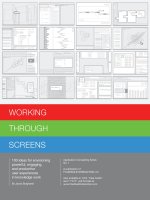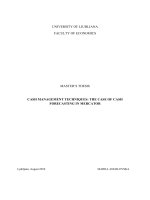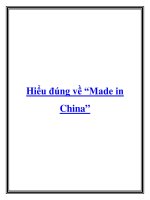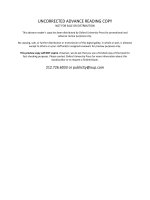User case in SCM.pdf
Bạn đang xem bản rút gọn của tài liệu. Xem và tải ngay bản đầy đủ của tài liệu tại đây (796.25 KB, 22 trang )
The Fundamentals of
Business Case Development
for Supply Chain Planning
Technology Investment
Contents
1. Why the Business Case is Critical to Drive Forecasting and
Replenishment Technology Investments1
2. Building the Better Business Case: Family Hypermarket’s
Supply Chain Starting Point and Improvement Needs
3
2.1 Assessing the Current State of Forecasting and Replenishment
4
2.2 Identify Challenge Areas and Improvement Needs
5
2.3 Develop Realistic Improvement Goals6
3. Family Hypermarket’s Business Case for Investing in Supply
Chain Technology10
3.1 The Financial Benefits of Improved Forecasting and Replenishment
11
3.2 Considering the “Intangibles” for Retail Technology Investment
15
4. The Key Takeaway: Using Real Data Will Drive the Most Reliable Results
17
1.
Why the Business
Case is Critical to
Drive Forecasting and
Replenishment Technology
Investments
1
Retail is undergoing a rapid digital transformation. New technologies are emerging
faster than ever, unlocking new benefits in all facets of the business. This is
especially true in supply chain management, where ever-evolving customer
behavior changes, the creation of new sales and fulfillment channels, and an
endless string of disruptive events mean that manual processes have become
completely ineffective. Leading retailers, those who strive to innovate their supply
chain, operate at a much higher level of efficiency, speed, and accuracy than the
laggards in their industry.
New technology, however, requires significant investment. How can you, as a
retailer, know that you are looking at the right solutions, basing your evaluations
on the best possible estimations for costs and benefits, and ensuring that your
investment in forecasting and replenishment technology will ultimately pay off?
The best way to address these concerns is by creating a business case and
calculating the potential ROI for the supply chain technology investment. A
business case enables you to evaluate a potential investment based on its
expected benefits. It highlights the core value drivers for your business, helps you
separate must-have features from nice-to-have features, and facilitates internal
communication and organizational buy-in. Finally, if you decide to move forward
with the investment, the business case enables you to set clear goals for your
technology implementation.
!
Figure 1: A business case is like a puzzle—you need to assemble the pieces in the
right order.
2
2.
Building the Better
Business Case: Family
Hypermarket’s Supply
Chain Starting Point and
Improvement Needs
3
To demonstrate best practices for building a business case and put perspective on
some of the primary considerations when working with return on investment (ROI)
calculations, this guide will follow a fictional model retailer, “Family Hypermarket.”
Family Hypermarket is a $5 billion general merchandise and grocery chain based in
the United States. They operate 100 stores and five distribution centers, carrying
an average of 40,000 SKUs per store. Family Hypermarket is also experiencing
rapid growth in their online channel and offer fulfillment from DCs as well as the
option to buy online and pick up in store (BOPIS).
2.1 Assessing the Current State of Forecasting and
Replenishment
Too many retailers lack an accurate picture of their business as a whole. Building a
business case for a supply chain technology investment is about more than just the
technologies and tools. It’s vital to understand where you are today before you try
to put together a plan for where you want to go.
Let’s take a closer look at Family Hypermarket’s current supply chain and the
factors that initiated their focus on forecasting and replenishment technology.
Family Hypermarket currently relies on store department managers to place
replenishment orders that keep shelves filled. However, due to the volume of
products being reviewed, these replenishment orders are frequently subject to
human error. While replenishment of their distribution centers (DCs) is more
automated, it is still far from advanced. Their DCs leverage their enterprise
resource management system (ERP) to forecast outbound deliveries using simple
time-series algorithms, such as exponential smoothing. Family Hypermarkets’
demand planners then manually adjust the resulting forecasts to accommodate for
things like upcoming promotions or local events.
Family Hypermarket’s ERP sends order prompts to supply chain planners. However,
these orders frequently need manual adjustment because the ERP system can’t
automatically accommodate suppliers’ minimum order requirements or the need
to fill trucks or containers. Store replenishment and DC replenishment are also
disconnected, leaving demand planners at the DCs a lack of visibility into when
and in what quantities stores will need inventory to stock up for seasons and
promotions.
4
2.2 Identify Challenge Areas and Improvement Needs
Family Hypermarket’s new SVP of Supply Chain, Sue, has recently joined the
company after spending the last few years with another retailer that invested in
more modern supply chain management. Although Family Hypermarket’s low-price
strategy has been successful and the company is growing, Sue is convinced that
Family Hypermarket needs to follow in the footsteps of other leading retailers who
have implemented solutions such as:
Automated demand forecasting at the SKU-store/channel-day level that responds
to recurring demand patterns such as seasonality and weekday-driven variation
in sales, the impacts of business decisions such as promotions and assortment
changes, and external demand influences such as weather.
Automated store replenishment that can be managed by a central team of
experts rather than store associates, requires little manual intervention, optimizes
safety stocks, and considers replenishment schedules and shelf presentation needs.
Allocation optimization that leverages attribute-based forecasting for new or
seasonal products to improve accuracy, drive efficient initial allocations and rampdowns, minimize residual stock, and enable efficient assortment changes.
Integrated supply chain planning where stores’ projected inventory requirements
and forecasted online sales drive automated DC replenishment, creating a
connected supply chain with a more efficient flow of goods and end-to-end
visibility into inventory and resource requirements across the supply chain.
End-to-end demand and supply visibility across the supply chain, which enables
proactive management of scarce inventory and capacity bottlenecks, the use of a
single stock pool to serve both store and online demand, efficient use of clearance
markdowns, and shared visibility and collaborative planning with upstream
suppliers.
Improvement in these areas would reduce Family Hypermarket’s operating
expenses and free up working capital.
To better understand the potential impacts on their value drivers and the expected
return on investment, Sue works to create a detailed business case for investment
in modern supply chain solutions to present to the company’s board for approval.
5
2.3 Develop Realistic Improvement Goals
Based on her experience, market research, and initial discussions with potential
vendors, Sue has identified the following improvements that she believes Family
Hypermarket can realistically attain through smart investment in better forecasting
and replenishment:
Improve omnichannel availability with advanced demand
forecasting and end-to-end inventory management
One of Sue’s primary goals is to increase availability for all of Family Hypermarket’s
channels through a supply chain planning solution with demand forecasting
capabilities advanced enough to fuel end-to-end inventory optimization. Currently,
they experience issues with unnecessary overstocks and out-of-stocks due to their
disconnected supply chain processes.
Planners in the DCs need more insights to create granular, day-SKU-channellevel forecasts. These forecasts would feed into automated store replenishment,
while inventory requirements for online demand would feed into DC inventory
requirements and projected orders to suppliers.
An advanced demand forecasting solution will enable Family Hypermarket to
consider hundreds of demand-influencing factors and their impacts with a high
level of precision and automation across all locations and sales channels. As
a result, planners can support a wide range of short- and long-term planning
activities, from replenishment planning to capacity management.
Sue’s goal for a solution implementation is to drive Family Hypermarket’s
omnichannel availability up from 92% to 95%.
Reduce inventory levels for improved turns
Along with availability improvements, Sue seeks to reduce Family Hypermarket’s
overall inventory levels and drive better inventory turns. Improvements in
store ordering accuracy and effectiveness from an advanced forecasting and
replenishment solution will enable Family Hypermarket to confidently provide the
right products to their customers at the right time. This increases sales through
better availability in-store and online and reduces the need to tie up money and
6
storage space on back stock. It also impacts other parts of the supply chain, such
as handling, storage, and wastage costs.
Family Hypermarket’s inventory cost for stores and DCs is currently $104 million.
Sue is targeting a 20% reduction in inventory, as well as an uplift in inventory turns
as a result of optimization.
Reduce waste in stores and DCs
Managing fresh items requires accurate, granular demand forecasting at the
store-product-day level. Sue knows that the ability to capture impact factors like
seasons, holidays, local events, pricing, promotions, and cannibalization is the key
to fresh forecasting and the ability to balance high availability with a low risk of
waste.
Sue also wants to enable Family Hypermarket’s safety stocks to account for
weekday variations in expected sales volumes. She knows that safety stock
levels that guarantee availability on Saturday could mean waste on Monday if not
adjusted properly. A good retail planning system performs this kind of dynamic
safety stock optimization automatically, keeping waste and availability in balance
and driving the highest profits possible.
Spoilage in Family Hypermarket’s fresh categories accounts for approximately $75
million annually, and availability averages 90%. Sue is confident that they can
reduce spoilage by 30% while maintaining or improving shelf availability.
Reduce associates’ time spent placing orders in stores
Large-format retailers like Family Hypermarket have tens of thousands of SKUs to
manage. Sue is becoming painfully aware that they can’t achieve accurate itemlevel control through manual store ordering. Decentralized replenishment creates
visibility gaps between stores and planners, requiring an inordinate amount of
guesswork when manually reviewing things like past promotions to estimate
upcoming needs.
7
Currently, store associates spend more than 300,000 hours annually in Family
Hypermarket’s 100 stores manually creating replenishment orders. Sue knows
that reducing manual ordering time will translate into better customer service,
lower stress levels for existing employees, and less pressure to hire additional
employees—an important benefit given how difficult it can be to recruit talented
store staff.
Sue’s goal is to use a solution that will centralize replenishment processes to a
core team. While store employees will still need to put in some effort to ensure
inventory balances are correct, Sue estimates that Family Hypermarket will be able
to cut in-store hours on these tasks by 85%.
The automation of demand forecasting and DC replenishment will free up a
considerable amount of time for Family Hypermarket’s central planning team.
They can spend that time focused on overseeing store replenishment and engaging
in collaborative planning with key suppliers. Therefore, Sue is not equating time
savings with a reduction in headcount.
Reduce goods handling costs in stores and DCs
A large portion of Family Hypermarket’s operational costs is tied to goods handling,
which is typical in retail. Sue estimates they can reduce their current annual cost
of $150 million by optimizing the quantities of goods ordered to DCs, leveling
goods flows across their supply chain, and consolidating store replenishment
according to available space. Automated ordering and replenishment can also be
optimized for fresh categories, which often peak later in the week in preparation
for consumers’ weekend shopping.
Smoothing the inbound goods flow to stores will help level Family Hypermarket’s
workloads, increase their cost-effectiveness, and significantly reduce capacity
issues without hampering on-shelf availability. Beyond reducing store handling
costs, optimization will also reduce DC picking costs by further decreasing the
number of store order lines. In addition, levelling goods flows will simplify Family
Hypermarket’s replenishment planning for promotions and major holidays.
8
Improve margins on markdown products
Sue has determined that Family Hypermarket is losing over $107 million per
year in margin due to clearance markdowns. She wants to automate markdown
management and create a proactive approach that better balances inventory by
clearing out discontinued or outdated products to make room for new products
coming in.
Optimization in this area would ensure that the right products are marked down
at the right time and the right discount to effectively clear out that unwanted stock
while protecting margins and gaining as much revenue from clearance inventory
as possible. Further, an automated approach would reduce the amount of time
and effort associates put into juggling the movement of old products and new
ones. While Sue does not currently have an estimation of how much time store
employees spend on this task, she anticipates a substantial reduction in hours and
stress for those associates.
Using industry benchmarks, Sue estimates markdown optimization could provide
an 8% increase in Family Hypermarket’s margin for markdown products.
She has set specific and measurable goals for both the vendor and her internal
implementation team to ensure that everyone understands what they need to
deliver when the new technology is introduced.
9
3.
Family Hypermarket’s
Business Case for Investing
in Supply Chain Technology
10
$
$
Figure 2: To get the most out of your business case, you need to take wellresearched data and turn it into benefit estimations that align with and support
your supply chain goals.
With the help of Steve, a business controller from the CFO’s team, Sue’s next step
is to translate these expected benefits into financial impacts. She knows some
benefits will be hard to quantify, so she also creates a list of intangible, or socalled “soft” benefits.
3.1 The Financial Benefits of Improved Forecasting and
Replenishment
1. Improved on-shelf availability that drives additional sales
and profit
Family Hypermarket’s average availability stands at 92%. Through research and
benchmarking, they estimate that even though customers frequently substitute
products, 30% of stockouts lead to lost sales.
Using an advanced solution to connect their end-to-end supply chain would yield
an estimated availability increase of 3% points. This increase would result in a
potential revenue increase of $45 million annually, leading to a profit lift of $13.5
million.
11
2. Reduced inventory value saves on carrying costs
Family Hypermarket determined their inventory carrying cost to be 12.5% of their
$833 million inventory value, totaling $104 million in carrying costs across stores
and DCs.
With an assumed inventory reduction of 20%, they are looking at potential annual
savings of $21 million in carrying costs and a more than $166 million reduction in
capital tied to inventory.
3. Cost savings through reduction in waste
Family Hypermarket determined that waste costs accounted for 1.5% of their
revenue, totaling $75 million annually. While fresh items make up a smaller
percentage of their range than traditional grocers, this is still a significant issue
to be addressed in their evaluation.
Implementing an AI-enabled forecasting solution would give Family Hypermarket a
benchmarked improvement of approximately 30% across DCs and stores, resulting
in savings of more than $22 million annually for their fresh products.
4. Reduced time spent placing orders in stores
A review of the time store employees spend on manual ordering revealed that
across their 100 stores, Family Hypermarket’s department managers spent more
than 310,000 hours annually on store ordering alone. That’s the equivalent of
approximately 150 full-time employees and costs the business $9 million annually.
While Sue expects manual ordering in stores to be removed entirely, she knows
stores will spend time on associated tasks such as inventory counts and that the
automation is based on accurate inventory balances. She therefore estimates that
centralized, automated replenishment will reduce the time store associates spend
on ordering tasks by 85%. Financially, this means a $7.7 million annual savings
on hours spent on manual store ordering. However, because Family Hypermarket
is growing and continuously hiring more store associates, these savings will be
realized in the form of a slower staff increase instead of fewer work hours for
existing employees.
12
5. Reduced goods handling costs in stores and DCs
Family Hypermarket assessed handling costs as 3% of their revenue, or $150
million, across stores and DCs.
An estimated 3% reduction in DC inbound order lines would reduce DC goods
receipt costs by $1.5 million. A 12% reduction in store order lines would reduce DC
picking and store goods handling costs by $12 million.
6. More efficient clearance markdowns increase profits and
reduce costs for products being phased out
Family Hypermarket currently leaves inventory clearance for stores to handle on
an individual basis. Based on current practices, the percentage of revenue from
markdowns, and their average discount, they have calculated that they are losing
more than $107 million in margin each year on the use of discounts to clear out
stock.
After applying estimations from their vendor, Family Hypermarket calculated
that optimizing markdowns would result in an average 8% increase in margin for
clearance items, giving them a $20 million annual profit increase.
The total financial impact
After completing all her calculations, Sue is confident that implementing a
solution that combines more accurate forecasting, inventory optimization, and
order optimization will enable Family Hypermarket to achieve their goals. Her
confidence in her case comes from the fact that she used an accurate currentstate assessment of the business and that she understands not only the ROI of
the potential investment, but also the key drivers behind the expected financial
outcome.
Sue’s business case shows a total potential annual savings of $98 million dollars
once the new solution has been rolled out. She also takes into consideration the
one-time benefit of $166.6 million savings in capital tied to inventory.
13
Figure 3: Adding together all the individual benefits gives Sue a total potential
annual savings of $98 million dollars. Her work so far has armed her with not only
the financial outcomes, but an understanding of the key drivers of those benefits.
14
3.2 Considering the “Intangibles” for Retail
Technology Investment
The business case calculations that Sue put together show compelling financial
benefits for acquiring modern supply chain optimization technology. However, she
still needs to consider her list of “soft” benefits—those that are not as quantifiable
as the above calculations, but which nonetheless will add considerable value to
the Family Hypermarket business. In many ways, these added efficiencies and
future-looking benefits can weigh as heavily in the business’s decision as hard
numbers.
1. Speed of implementation
Sue is fully aware that the business case outlines a major investment, and that
every month that a go-live is delayed could cost Family Hypermarket millions in
savings they could have realized earlier. The biggest impact on Sue’s ROI will be
determined by how quickly they can complete the implementation, put their new
solutions to work, and start reaping the benefits of the investment.
2. Total cost of ownership
Family Hypermarket’s current ERP system has undergone heavy customization over
the last several years to sustain the business. Sue will need to evaluate the cost of
customization for the solutions she is considering as well.
Flexible systems that can be quickly customized by a core team of expert users
are much more cost-effective than those that need a lot of vendor intervention. As
Family Hypermarket’s IT department is continuously resource-constrained, Sue will
dig deep into what changes and adaptations their supply chain team could take
ownership of themselves and to what extent they would need to rely on external
assistance.
Sue is also looking forward and assessing the ease and costs of integrating future
projects. For example, she knows that Family Hypermarket will replace one of its
old DCs with a new one in a couple of years. She is also aware that their click-andcollect offering is gaining momentum and will need considerable integration and
planning capabilities soon. Both examples will require speed and agility to execute.
15
Ideally, their new solution will allow them to manage those projects without heavy
reliance on the vendor or their internal IT department.
Additionally, Sue is aware that modern software as service (SaaS) solutions help to
cut costs by not generating additional server, backup, and maintenance costs.
3. Driving additional value for the business
Finally, Sue is interested in how the investment plan can tie into and drive
additional value to the rest of the business. Forecasting and replenishment are
core functions for retailers, and the benefits of optimization ripple out to the
entire business. For example, automated and more accurate demand forecasts
can help with other aspects of planning, such as workforce needs for seasonal
and promotional spikes, merchandising and space planning, and supplier
collaboration.
Also, from an IT standpoint, it’s always easier to engage with a smaller number of
very competent suppliers than a large number of vendors that are hard to keep up
with. By consolidating as many solutions as possible with a single vendor, Family
Hypermarket can streamline all of their processes into a unified, interconnected
environment.
16
4.
The Key Takeaway: Using
Real Data Will Drive the
Most Reliable Results
17
As we’ve demonstrated in our hypothetical Family Hypermarket example, building
a business case and calculating ROI is a necessary exercise when considering
any major change or investment in retail supply chain technology. It is especially
valuable because it forces you to scrutinize, in detail, your current state and key
value drivers and develop realistic goals. However, to get truly reliable numbers on
the expected benefits, you must get to a much more granular level than averages.
Industry benchmarks are useful, but simulations that leverage real-life, highly
granular data will offer much more valuable insights. Many technology vendors
would be more than happy to help you review your detailed data and show
what would change per SKU-channel-day with more accurate forecasting and
replenishment. This provides a more accurate understanding of the financial
implications these changes would have for your business.
While not all retailers have every type of data or research resource available,
collaborating with the vendor to agree on the closest numbers possible is a good
idea. Further, when talking to vendors about the assumptions they provide for
benefits, those assumptions will ideally be based on experience and not simply be
invented numbers.
18
Authors
Johanna Småros
Co-founder
RELEX Solutions
Emma Aidanpää-Salmi
Vice President, Customer
Success
RELEX Solutions
Eero Äijälä
Director, Product Adoption
& Excellence
RELEX Solutions
David Sahota
Lead Field Strategist
RELEX Solutions
19
About RELEX Solutions
RELEX Solutions is a leading provider of cutting-edge retail optimization
software that’s built for the age of Living Retail, where change is the
only constant. We help retailers adapt to every future, faster.
Our cloud-native Living Retail Platform delivers pragmatic AI across
all retail functions and at retail scale, eradicating siloes, rigidities
and inefficiencies along the way. We offer a fast lane to value that
builds from a foundation of radically improved demand forecasting
and supply chain optimization. Our customers leverage this enhanced
supply chain visibility into exponential benefits — optimizing their
space, allocation, workforce, promotion, and markdown strategies, all
within our unified platform.
Today, RELEX is a hyper-growth company with 350+ customers who
love us — ask any of them for a frank and independent assessment of
our team and solutions. RELEX is trusted by leading brands including
AutoZone, Franprix, Morrisons, PetSmart and Rossmann, and has
offices across North America, Europe and the Asia Pacific region.
Go to relexsolutions.com for more.
20









